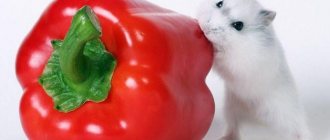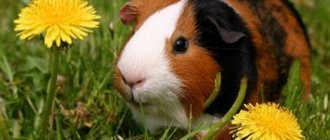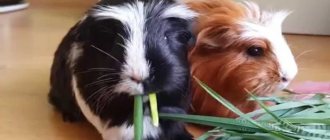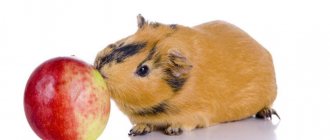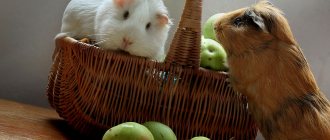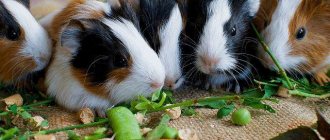Vegetable menu
Pigs have to look for vitamin C, which is responsible for the functioning of connective and bone tissues, from the outside, since their body is not able to produce it on its own.
Guinea pigs love apples, cucumbers and carrots.
Ascorbic acid enters the body from plant foods, including fresh vegetables (broccoli, bell pepper), amounting to at least 1 teaspoon per day.
Vegetables that can be given to guinea pigs include:
- . Rich in vitamins, minerals and pectins, which normalize intestinal motility.
- Carrot
. Positively affects the condition of the skin and coat, visual and auditory functions. In addition to root vegetables, it is allowed to feed tops. The beta-keratin (vitamin A) content gives urine an orange tint. - Bell pepper
. Rich in vitamin C, but dangerous in winter due to the amount of harmful nitrates. Only sweet varieties are allowed as food, while spicy ones lead to irritation of the mucous membranes. - Pumpkin
. Not only the pulp is eaten, but also the crust and seeds, which are rich in zinc and act as a prophylactic against helminthiases. - . Low in calories, have an anti-inflammatory effect and facilitate the absorption of fats. Not suitable as a main food and dangerous in winter (high nitrate content).
- Fresh peas
. It is recommended to feed your pets only fresh pods, without overusing the quantity. Dried grains should not be consumed, but some manufacturers add them to ready-made food. - . Requires competent control. It is introduced gradually to avoid excessive gas formation. Rich in sulfur, which synthesizes collagen and adds shine to the coat.
- Rutabaga
. Helps with constipation, facilitating peristalsis, and has a diuretic effect. Recommended for use in winter, when the choice of vegetables becomes limited. - Jerusalem artichoke
. The consumption of root vegetables enriched with starches should be limited to avoid intestinal disorders. The remaining parts, rich in fiber and amino acids, are allowed on an ongoing basis.
Controversial and dangerous vegetables include:
- Tomatoes
. In their green (unripe) form they are considered poisonous due to solanine; consumption of the tops is also not recommended. Ripe tomatoes, containing a large amount of vitamins, undergo destruction by dangerous poison, so they can be included in the diet in limited quantities. Avoid tomato abundance, which provokes intestinal upset. - . Another vegetable rich in poisonous solanine and starchy substances.
- Melon
. Dangerous for the development of diabetes due to the abundance of sugars. - . Essential oils irritate the mucous membranes and cause bloating.
- . Has a laxative effect. Not recommended during pregnancy, lactation and older age
- . Only green parts are allowed for food. Grains are dangerous due to the abundance of starch, which interferes with digestion and leads to weight gain.
Useful vitamins and other elements
The main composition of this vegetable includes water with a modified structure, which is very beneficial for the stomach and digestion.
Vitamins and the benefits they bring to the animal can be viewed in the table below:
| Vitamin | Benefit |
| Vitamin C | Supports immunity |
| Vitamin B9 | Fights anemia |
| Vitamin PP | Supports proper organ function |
| Vitamin H | Good for the nervous system |
| Vitamin B3 | Supports proper organ function |
| Vitamin B6 | Important for the immune and nervous system |
| Vitamin A | Helps improve vision |
| Vitamin B1 | Activates the work of all internal organs |
Did you know? These cute rodents get their name from the grunting sounds they make and their gluttony. They began to be called sea creatures, since the fluffies came to our country from overseas, from South America.
Table of minerals found in this product and their properties:
| Mineral | Benefit |
| Iron | Important for good blood |
| Potassium | Necessary for normal functioning of skeletal muscles |
| Phosphorus | Strengthens bones and teeth |
| Magnesium | Supports heart rhythms |
| Sodium | Important for the digestion and excretory system of the body |
Fruit menu
Feeding fruit to a guinea pig is strictly dosed.
Fruits are rich in sugars, therefore they are not considered as a complete part of the diet, but exclusively as a treat.
Among all the abundance of fruits, only apples can be consumed by a guinea pig without strict restrictions. They normalize digestive processes and remove toxins. The seeds must be removed as they contain toxic toxins.
The following berries are allowed to be consumed:
- . The abundance of fiber and vitamin B has a positive effect on the body. Thanks to their pleasant taste, the animal eats berries with great pleasure.
- Arbuzov
. Only the pulp is fed to the animals. Crusts accumulate nitrites and are considered dangerous. Due to the diuretic effect, the amount eaten is kept to a minimum. - Rowan berries
. Chokeberry replenishes vitamins C and P, and red chokeberry replenishes carotene.
Controversial and dangerous berries and fruits include:
- . Irritate mucous membranes and provoke allergic reactions.
- . It is fraught with an excess of vitamin C, leading to allergies, diarrhea, gastritis and ulcers. It is given in tiny doses no more than 1-2 times a week.
- . They replenish glucose and fiber, but due to the increased calorie content and sugars they are consumed to a minimum.
IMPORTANT! When preparing your diet, please note that marine rodents are herbivores. Meat and are not digested by their body and pose a serious danger.
Apple pits must be removed
Berries and fruits
Natural berries and fruits contain the bulk of the vitamins your guinea pig needs, not just the treats your guinea pig loves. Fruits are not forbidden to the animal; they can be included in the daily diet, the animal will choose what it likes more, and advice from a veterinarian on nutrition is also possible. Veterinarians do not recommend giving your guinea pig a lot of sweet fruits. They are more likely to have indigestion, which occurs more often in them than in other rodents. A large number of sweet tangerines, apples and pears can cause just such a disorder. Give tangerines to your pet with particular care. They are, of course, an essential source of vitamin C, which the pig's body does not produce, and citrus fruits are the main source. But tangerines are strong allergens. You can give a little, a slice every day and watch the behavior of the guinea pig to see if it has developed an allergy.
Special feed
Particular attention should be paid to the choice of purchased food for guinea pigs. Not all specialized mixtures presented in pet stores are suitable for these animals. When choosing food, you need to evaluate it according to the following criteria:
- Compound.
Herbal granules should predominate in it, other components should be kept to a minimum. Unshelled sunflower seeds can get stuck between teeth; corn is of no value to pigs; cereals are contraindicated, and cereals are too high in calories and are only suitable for animals that need to gain weight. - Granule size.
Granules found in chinchilla or guinea pig food are suitable. Formulas intended for rabbits and other larger animals usually contain large granules that are difficult for guinea pigs to eat. - Best before date.
Expired food can be harmful to animals and there is a risk of negative effects on the digestive system.
Below are examples of foods that meet all the criteria and are approved by professional breeders and ratologists:
is a complete, high-quality granular food for guinea pigs, containing a complex of essential vitamins. The composition additionally includes herbal additives that have a positive effect on digestion, and pressed cereals are completely excluded. The cost is 250-350 rubles for a package of 750 grams and 750–850 rubles for a package of 2.5 kg.
It is the most popular food; specialized mixtures for guinea pigs and universal mixtures intended for all rodents are suitable. The granules are made from 60 different herbs; cold pressing technology is used for their production, which allows you to preserve all the vitamins, minerals and beneficial chemical elements. The cost of a 750 g package is about 250–300 rubles.
Formulas intended for guinea pigs and chinchillas are suitable as they have a similar composition. The cost of one kilogram package varies from 150 to 350 rubles.
is a rather expensive food, but it has a high level of quality. The composition includes large granules containing the necessary fibers, allowing the mixture to be better absorbed. The cost of a kilogram package is 400–500 rubles.
"Animals"
is one of the few budget foods that is suitable for guinea pigs. It is necessary to purchase a mixture intended for chinchillas, since other varieties produced under this brand are too high in calories and can lead to obesity. The cost of packaging is 80–100 rubles.
Vegetables
Can guinea pigs have radishes?
It is permissible to use only radish tops. The root vegetable contains essential oils that can cause irritation to the mucous membranes and respiratory tract of the animal. The vegetable also causes bloating. Therefore, it is not recommended to give radishes to pigs.
Can guinea pigs eat celery?
Celery can be given in any form - stems, leaves, roots. This vegetable is included in many dry food for rodents. Celery is enriched with vitamins B, PP, E, C, A and contains phosphorus, zinc, potassium, calcium, iron and magnesium. Before eating, celery must be washed thoroughly, especially the root.
Can guinea pigs eat tomatoes?
Ripe fruits can be included in the food. Tomatoes are well absorbed by animals and contain vitamin C and carotene, which are beneficial for their body. Green tomatoes contain solanine, which can negatively affect your pet’s health.
Too many tomatoes in an animal's menu can cause loose stools.
Can guinea pigs eat cabbage?
Cabbage can be included in the animal's diet. Cabbage contains many vitamins and other substances necessary for pigs:
- ascorbic acid;
- B vitamins;
- vitamins of the PP group;
- folic acid;
- sulfur;
- calcium;
- potassium;
- phosphorus;
- amino acids;
- microelements.
Today we have cabbage lunch
The vegetable is able to keep the animal’s fur in excellent condition and strengthen its immunity. The top dried leaves should be given. It is preferable to feed guinea pigs Chinese cabbage and broccoli. White cabbage can cause bloating.
Can guinea pigs eat potatoes?
Green and sprouted potatoes are contraindicated for guinea pigs. Raw vegetables can be given occasionally, cut into small pieces. Boiled potatoes can be offered to your pet separately or added to grains and other foods.
The vegetable contains solanine, which can harm the health of the animal if the pet eats too many potatoes. The pig will become passive and catch cold quickly.
Can guinea pigs eat beets?
Beetroot contains many substances useful for animals: vitamins C, A and B, potassium, magnesium, phosphorus, iron. In excess, the vegetable contains fiber, so it acts on the animal’s body as a laxative. Store-bought root vegetables may contain nitrates, which are very harmful to the small body of guinea pigs. It is better to offer your pet homemade crops. The composition also contains a large amount of oxalic acid, so it is better to limit the consumption of this product.
It is recommended to give beets starting from 2 months; they are especially useful in winter and spring, when there are no fresh vegetables. The daily dose should not exceed 200 g, and it is better to exclude beets from the diet of pregnant and lactating pigs so as not to provoke an upset stomach. Beets turn stool and urine red, so if your animal has eaten them, don’t be alarmed by such changes.
Can guinea pigs eat pumpkin?
Pigs can be given all varieties of pumpkin that humans eat. For the digestion of herbivorous animals, such a product will be familiar and useful. Pumpkin contains vitamin C, calcium and phosphorus necessary for rodents. It should be borne in mind that this low-calorie vegetable will not be able to saturate the pig completely, so it is better to give pumpkin to guinea pigs as a treat.
Can guinea pigs eat bell pepper?
Another storehouse of ascorbic acid is bell pepper. Before use, the vegetable must be thoroughly washed and chopped, and the seeds removed. It is better to give the product together with dry food.
Green peppers containing solanine should not be given to animals, as should peppers in the form of hot seasonings. Spicy foods will damage the mucous membranes.
Can guinea pigs eat cucumber?
Cucumbers don't have as many nutrients as other vegetables. You can offer your pet a cucumber. The vegetable can harm your pet's health by causing digestive problems only if consumed in large quantities.
Can guinea pigs eat zucchini?
Zucchini is suitable for the diet of guinea pigs. They contain small amounts of vitamin C, calcium and phosphorus. It is better to prefer young vegetables; they can be given along with the peel, cut into crowbars.
Foods that are contraindicated for guinea pigs
Every guinea pig owner should know foods that are contraindicated for feeding these animals. These include:
- Potatoes in any form.
Root vegetables are rich in starch, which is very difficult to digest, and green sprouts are toxic and poisonous due to the high concentration of corned beef. For the same reason, you should not include green parts of peppers or tomatoes in your diet, although ripe fruits are completely safe. - Legumes
cause bloating and negatively affect the functioning of the digestive system. Only green sprouts can be included in the diet, but only in minimal quantities. - Radishes and radishes
are also contraindicated due to the large amount of essential oils, which can irritate the mucous membranes and lead to complex malfunctions of the digestive system. The restrictions apply only to root vegetables; tops can be included in the diet; occasionally it is allowed to give a small amount of mild radish. - Rhubarb and sorrel
contain high levels of acid, which makes them toxic to guinea pigs. - Any bulbous
plants. - Food of animal origin, milk.
In the body of guinea pigs there are no enzymes responsible for the breakdown of the components included in such products. - Seeds of apples, plums, peaches and other fruits.
They contain a large amount of hydrocyanic acid: in small amounts it can be beneficial for the body, but systematic use can lead to serious problems with the respiratory and digestive system, cause a convulsive reaction and even death. - Bread.
Many people mistakenly believe that only soft bread is contraindicated for guinea pigs, and that crackers help wear down teeth. Such food contains undesirable components and is difficult to digest, and guinea pigs’ teeth are easily worn down when eating hay and hard vegetables. For the same reason, the cage should not contain salt stones, which can often be found in pet stores. - Store-bought treats for rodents.
They contain honey, sugar and other types of sweeteners, which provoke increased calcium consumption in the body, fermentation in the intestines, addiction and fatty liver. - Cereal grains
and corn are high in starch and are not a natural food for guinea pigs. - Dried fruits and vegetables
have a high concentration of sugar and are bad for the intestines; all these products can only be given fresh. - Vitamin supplements in food or drink.
You can buy them at a pet store, but give them to animals only as prescribed by a specialist; healthy animals receive the necessary set of vitamins and minerals from the basic diet. - Juices
and any other drink except plain water. - Nuts
contain too many essential oils, fats and acids, which slow down the digestion process. As an exception, they can be given in small quantities to animals that lead an active lifestyle and live not in cages, but in pens. - Any products that have undergone heat treatment.
- Mushrooms.
- Houseplants and ornamental plants - virtually all of them are poisonous to rodents.
Recommendations for feeding the animal
A couple of tips that you can’t help but pay attention to:
- Do not feed your animal vegetables that are not fresh; if the vegetable is limp in appearance, then you should not give it to the animal.
- Do not give food from the freezer to your pet, as this can cause diarrhea.
Young fruits should be used to feed the animals. It is not necessary to peel off the skin; guinea pigs can eat zucchini with the skin on. But it is necessary to wash the fruit.
Can a guinea pig eat raw zucchini? Yes, it is best to cut the vegetable into small pieces that will be convenient for the animal to eat. It is better if the animal eats the treat right away, since zucchini is a vegetable that spoils quickly.
Healthy Supplements
The most common dietary supplement is vitamin C, which is diluted in drinks. It is not produced in the body on its own, but if the basic feeding rules are followed, guinea pigs receive it in sufficient quantities from fresh vegetables and feed mixtures. Vitamin C can be used as a supplement only as prescribed by a ratologist; usually such a need arises if we are talking about a weakened stomach or a prolonged period of artificial feeding.
Table of allowed vegetables, herbs, herbs, fruits, berries
Adult pigs require from 10 to 20 mg of vitamin C per day. The need for vitamin C may depend on seasonal fluctuations, under normal conditions, pigs kept in an apartment require from 10 to 15 mg, pregnant females about 20 mg. You can see how much your pigs actually get of this vitamin in the table. Keep in mind that products lose some of their vitamins during long-term storage in winter; vitamin C in them is reduced by an average of 1/3. All data in the table are average values, since the availability of nutrients is influenced by many factors, for example, storage conditions, types of varieties (different types of carrots, different varieties of apples), seasonality, etc. If you give fresh foods, then you shouldn’t give additional vitamin C, because it can only do harm. When there is an excess of vitamin C, the urine becomes acidic and a predisposition to kidney damage and skin irritation develops.
The calcium/phosphorus balance should be 1.5:1. For clarity, these data are shown in the table. In animals with kidney problems, too much calcium in the diet can lead to kidney and bladder stones.
Information
Unfortunately, it is not possible to find out the composition of all crops and indicate it in the list, so for some there is a dash.
Note:
As a rule, you can hear that cucumbers should not be given, because... contain a lot of water and little nutritional value. You can give cucumbers, but in moderation. In addition, one may hear that fresh food is rich in carcinogens and contains many chemicals, as a rule, such remarks are the result of false panic and are quickly spread in the media. In fact, all “harmful” substances are found in fresh foods, usually in very small quantities and do not pose any harm to health. If you see danger in everything, then the animals will simply have nothing to eat. For example, dill, which is now considered very healthy, has been considered dangerous for several years because it contains small amounts of safrole. The proportion of safrole in fennel is so low that it is not even significant for medical reasons. Carcinogenic safrole is effective only in large quantities (for example, in nutmeg, safrole from which is used as a medicine).
Information about substances:
Tannins: tannins include tannin. Its content, especially in the branches of old trees, can reach 20%. Tannin is used both in medicine and for processing leather products. Once in the pig's stomach, tannin is converted into gallic acid. And she, in turn, turns into pyrogallol, which is a poison. In experiments on animals there was an indicative result: pyrogallol changes cells at the DNA level. Hydrocyanic acid: unfortunately, it is still widely believed that tree branches with stone fruits (such as apricots, cherries, plums, etc.) contain hydrocyanic acid. This is not true! They do not contain hydrocyanic acid or amygdalin, which breaks down into hydrocyanic acid and fructose when reacting with water. Amygdalin is a constituent substance in the seeds of fruits, but not in the bark and leaves.
Making a diet for a guinea pig: This question tops the list of tasks that we mentally form when carefully carrying home a funny pet from the pet store. What do guinea pigs eat? Offhand, each of us will say that this must be some kind of grass and grains, perhaps bread. Yes, I remember the seller talked about hay, recommended some kind of food... What kind of food do rodents like? How much grain can they be given per day? What products are included in the ideal menu for rodents of the pig family?
[Hide]
What food is prohibited
Guinea pigs are not carnivores, they do not drink milk or eat meat products, they are true vegans.
When thinking about what to feed your pet at home, do not give him:
- porridge;
- dairy products, cheese and cottage cheese;
- meat and fish products;
- vegetable stew;
- eggplant;
- raw potatoes;
- night blindness;
- fern;
- sow thistle;
- wild rosemary;
- celandine;
- fighter.
You also shouldn’t give overripe or unripe fruits, vegetables, damp grains, old mixed feed; you also shouldn’t feed the rodent what you eat yourself every day. Do not give a lot of sorrel to your pet, it is not prohibited, but in small quantities.
The option is to give the animal store-bought food a couple of times a day, this is of course also an option, but how correct is it to feed the pig only this. This is suitable if the animal is not yours, and you were simply asked to look after the pet. But this is not the best option if you purposefully got yourself this pet. You should not care about the health and condition of your pet or how long your friend will live.
Diet
Of course, you can reduce feeding your pet to giving him “store-bought” food twice a day. He will eat it, but is it right to eat it? – Yes, if the animal was imposed on you, and your humanistic principle obliges you to give it food. No, if the guinea pig appeared in your house for a reason. In this case, you care about the state of her health and whether she will live a year longer.
When deciding what to feed your guinea pig, it is better to choose between the following options:
- mixed nutrition;
- natural diet.
Mixed nutrition involves feeding both ready-made grain or granulated mixtures and juicy fresh food. Such food can be fruits, melons (melon), sorrel...
Organizing natural nutrition at home will require a lot of effort from the owner. But the feeding process will bring immeasurably more pleasure! And the result - an active, healthy pet with shiny fur - will certainly please you!
Berries and fruits
Fresh fruits and berries are not only treats for guinea pigs, but also vitamins and minerals that pets need. Fruit can be given daily, depending on your pig's personal preferences and veterinarian recommendations.
As a general recommendation, experts advise not to overfeed your pig with sweet fruits. Like no other domestic rodent, guinea pigs are prone to frequent digestive disorders. And an overabundance of tangerines, apples, and pears on the animal menu can lead to failures of this kind.
Tangerines should be given to your pet with special caution. On the one hand, the pig’s body does not produce vitamin C, the richest source of which is citrus fruits. On the other hand, tangerines belong to the group of allergenic products. Tangerines can be offered a slice a day, carefully observing the reaction of the pig’s body.
Green feed
Rodents of the pig family love green food. When collecting dandelion or alfalfa leaves for your pet, choose places away from busy highways.
Rodents of the pig family happily eat clover, nettles, Chinese cabbage leaves, and sorrel. Greens can be selected individually, experimenting with foliage (celery, fennel, basil), shoots and excluding bulbous vegetables. Whatever greens you choose, sorrel, spinach, lettuce - everything that guinea pigs eat must be washed.
In winter, the choice of green food inevitably narrows to the store assortment. So that your pet can eat as many types of succulent greens as possible in winter, you can grow green food yourself. The owner of a guinea pig shares tips on how to do this in this video.
In addition, for the winter it is necessary to prepare hay for the pigs, by eating which the rodents wear down their teeth. Branches of fruit trees are also suitable for stitching.
You can also dry the leaves of sorrel, alfalfa, and clover. Even in dried form, these products contain a large amount of vitamins and microelements.
With the onset of spring, dry hay is gradually replaced by seasonal greens. This transition should be controlled, it should be as gentle as possible so as not to provoke digestive upset. It is not recommended to give grass that is wet from dew or rain to pets.
Grain feed
One of the components of a properly formulated guinea pig diet is grain feed. Rodents will eat wheat, corn, barley grains, lentils, peas, soybeans, sunflower seeds, and oats. You can also give them corn grains in small quantities.
In a properly designed pig menu, the share of grain feed should not exceed a third of the total food volume.
What are the consequences of an excess of grain in a pet’s diet?
- Overly nutritious grain feed will inevitably lead to excess weight gain.
- Grains are a source of a number of vitamins and microelements, but not all. By increasing the proportion of grain feed, the owner thereby reduces the intake of those beneficial substances into the animal’s body that are not found in grain. – They are present in greens, fruits and berries that a pet could eat in a day with a different ratio of diet components.
The animal eats grains only raw. An exception is made only for bread, which some pigs love so much. It is not recommended to give fresh white bread, let alone black bread - only well-dried bread! Rather, it should be bread crumbs. Feel free to give your pet a cracker or two a day: she will sharpen her teeth on it. In addition, the pig’s body will receive the full range of B vitamins contained in the bread.
Combined feeds
Tender greens, fragrant berries, ripe fruits, juicy vegetables and shoots, fragrant hay sufficiently provide the rodent’s body with the necessary substances. This is a natural and the best diet for your pet that can only be provided at home.
At the same time, different types of good feed with herbal and fruit granules attract attention. Mixtures may also contain various types of grains, honey, and dried fruits. And, although rodents of the pig family could easily do without granulated food, some owners still buy ready-made mixtures for their pets.
But, no matter how much manufacturers claim the exceptional benefits of ready-made mixtures, you should not make even a seemingly standard food the basis of a pig’s diet.
And you shouldn’t offer your pet food that contains:
- bone meal (in the wild, rodents of the pig family do not consume products of animal origin!);
- preservatives;
- corn based syrup;
- fructose;
- nuts.
Water and salt
The drinking bowl should be filled with fresh water once a day. If a rodent eats a mixed diet, it will drink more water than if it were on a natural diet. After all, juicy green food contains a lot of liquid, unlike dehydrated food.
If the animal's body does not receive enough fluid, the pet risks getting sick. The organs of the genitourinary system, in which stones can form, will be affected.
The pet needs salt. Like a block of chalk, a wheel of salt is placed between the bars of the cage. Salt contains minerals necessary for the normal development of the rodent. Feeling a lack of these substances, the guinea pig licks the wheel.
Pink wheel with salt
“Forbidden fruits” for rodents
What should you not feed guinea pigs? These rodents are not just vegetarians, they are vegans. That is, in the wild, an adult pig would never even think of drinking milk, much less eating meat. Guinea pigs are not predators.
At home, when preparing food for your pet, you need to take into account the following food taboos:
- milk, cheese, cottage cheese;
- meat fish;
- porridge;
- vegetable stew;
- raw potatoes;
- eggplant;
- night blindness;
- fern;
- wild rosemary;
- sow thistle;
- stick;
- celandine;
- fighter.
Overripe (or unripe) fruits, rotten vegetables, damp grains, expired feed, food from the owner’s table - all this is also “forbidden fruit” for rodents.
Although sorrel is included in the list of permitted foods, it should be given to the pig in small quantities.
Water
Every animal needs water and the guinea pig is no exception, although some breeders think differently, thinking that if the animal eats a lot of green grass, then it does not have such a need for water. But this opinion is not correct. All pigs need water, especially in hot weather and also for pregnant and lactating females. Fresh water should always be provided. It is better not to give a mug a drinking bowl, the water in it quickly becomes not fresh; for water it is better to take bottles - drinking bowls.
When it's hot outside, you can give the animals an open shelf so they can dip their paws in it. This cools the animal's body.
Feeding regimen and technique
Healthy adult guinea pigs are fed twice a day, while pregnant guinea pigs and babies are fed up to four times a day. With two meals a day, rodents are offered succulent food for “breakfast,” and grain or a grain mixture and greens are prepared for “dinner.” In winter, greens are replaced (or supplemented) with hay.
It may be an unpleasant surprise for first-time owners to learn that pigs (even piglets!) eat their own feces. But this is how nature has established it: it is in this unusual way that colonies of beneficial bacteria enter the pig’s body. If you do not allow your pet and her cubs to eat your litter, this will immediately have a negative impact on the health of the animals.
Daily ration
Once the owner decides what to feed the guinea pig, he should pay attention to feeding standards.
Here is an approximate daily diet for an adult from the pig family:
Some veterinarians recommend feeding guinea pigs milk in the amount of 0.025 liters per day, regardless of season and age. Let us beg to differ with them. Rodents should not be accustomed to milk, because nature has not provided their body with enzymes that help digest dairy products.
You should be careful about your pet, because the given nutritional standards may vary depending on:
- degree of animal activity;
- health conditions;
- age.
So, pregnant females need more food. Therefore, the volume of food eaten for them increases by 30%.
Sorry, there are no surveys available at this time.
Nutrition for pregnant pigs and newborn piglets
Pregnant pets must eat well and of high quality. The diet of furry mothers should be rich in proteins and vitamins. It is useful to give pregnant females carrots, beets, and wheat sprouts. You can periodically add a little milk to the water. Rosehip infusion brings great benefits to the body of a pregnant pig.
If the female who gave birth does not have milk, then the owner will have to feed the cubs on his own using a syringe. Artificial food for small piglets includes low-fat cream and the probiotic Linex. The cream is taken into the syringe and a tenth of the probiotic capsule is added to it. The resulting solution is nutritious and beneficial for the digestive system of babies. The food in the syringe is warmed to room temperature. Piglets take 1 ml of food every hour. Two-week-old babies can be switched to cereal porridge without milk. The piglets sit on the porridge until they get used to “adult” food.
animalsprotectionpetcare
is this possible for pigs?
can pigs do this ¶
From: Danary - January 21, 2011 12:52 pm
Tell me, is it possible to give pigs: celery greens, cilantro?
can pigs do this ¶
From: Riki-Tiki - January 21, 2011 1:41 pm
It is possible and even necessary. Only summer ones, grown naturally, and not winter ones in pots, grown with hydroponics and pesticides. True, not all pigs eat celery and cilantro because of their specific smell.
can pigs do this ¶
From: Marusya's mother - January 31, 2011 1:38
Mine loves cilantro, but not celery, even if the carrots lie next to the celery, then they won’t eat it unless they really want to eat it
can pigs do this ¶
From: Roni4ka - January 31, 2011 9:59 am
My celery is killed for my dear soul! But I was afraid to give cilantro, they wrote somewhere that it was forbidden.
can pigs do this ¶
From: susvinki - January 31, 2011 7:28 pm
can pigs do this ¶
From: Tasilda - January 31, 2011 8:23 pm
can pigs do this ¶
From: susvinki - February 1, 2011 8:13 am
Now this is no longer entirely true; many women resell bunches of dill, parsley and cilantro not from their gardens, but from the same greenhouses, especially in cities. This is the same situation as drunks and grandmothers walking on electric trains and selling greens, vegetables and fruits. Obviously, they don’t grow it themselves, either they buy illiquid goods in bulk from stores, or they choose from city landfills what they throw out of supermarkets. It is easier for large stores to throw out a box of spoiled vegetables and fruits than to spend money on sorting. Here the drunks and the money choose, launder and resell. Nowadays, few people grow and sell their own. I have a dacha in the village and every year I see that no one plants anything, it’s easier to buy flowers in the store, even the notorious bunch of dill and radishes.
can pigs do this ¶
From: Tasilda - February 1, 2011 11:11 am
We have 80-year-old grandmothers and grandfathers in our market who simply don’t have the strength to wander around the shops and choose illiquid goods. And the greenery is clearly its own - smaller and curlier.
( And country eggs with an orange yolk, too, would you say, from the store?
).
can pigs do this ¶
From: AlpenGold - February 1, 2011 11:40 am
I always took greenflies from “my” grandmothers (in spring and autumn). We always have them there. In winter with pickles, in warm weather - with fresh bunches and cucumbers. I buy almost everything. What kind of mint do they have?
Other products
Bread
Can guinea pigs eat bread? It's better not to give.
- Fresh yeast bread takes a long time to digest and causes fermentation in the animal’s stomach.
- White bread causes bloating.
- Your pet can eat stale bread, but not often.
- Dried bread with seeds, sesame seeds and raisins can sometimes be offered to your pet as a treat.
Can guinea pigs eat nuts and seeds?
Nuts and seeds are among the allowed foods, but can cause obesity if their consumption is not limited. It is better to offer your pet almonds, walnuts or hazelnuts.
Cucumber
A ripe cucumber is a source of water, potassium and vitamin C. Your pet likes the taste of a juicy natural product. Fresh fruit will quench thirst and normalize the process of assimilation by the rodent’s body of useful substances supplied with other food products.
It is better to give cucumbers to guinea pigs from your own garden.
During the season, the guinea pigs are given cucumbers grown in their own garden. A purchased harvest from a greenhouse may contain nitrates, which even in small doses can cause severe poisoning in an animal, resulting in death.
You can give cucumber to guinea pigs only in moderate quantities: a single serving is equal to a quarter of a medium-sized fruit.
Abuse of green vegetables provokes digestive problems.
Dairy
Can guinea pigs have milk?
Giving milk to guinea pigs is not recommended. The enzyme that is responsible for the breakdown of milk sugar (lactose) is found in insufficient quantities in the body of animals. If your pig drinks milk, the lactose will cause diarrhea and bloating. More serious diseases may develop in the future, so it is better to show your pet to a doctor.
Females can and even need to be given milk during lactation. You can soak crackers in milk and offer them to your pig.
The ban also applies to other dairy products: cottage cheese, cheese, yogurt and others.
